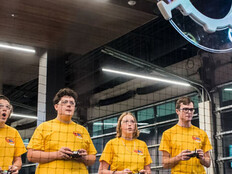Accessible Technology Helps Students with Disabilities Pursue STEM Degrees
Students with disabilities are now just as likely as other students to enroll in science, technology, engineering and math (STEM) fields when they enter higher education, recent research from the National Science Foundation reports. The study found that 11 percent of undergraduate degree pursuers have a disability, which Education Week indicates is on par with the 12 percent of K–12 students that have a disability.
As the STEM field clamors to add the expertise of those underrepresented, previous NSF research indicates that this expansion to disabled students is a win for these fields:
“First, the nation’s long-term prosperity is dependent upon ‘talented and motivated individuals who will comprise the vanguard of scientific and technological innovation.’ Second, every student in the United States ‘deserves the opportunity to achieve his or her full potential.’ … In short, excellence and equity in STEM education are interrelated.”
Recent updates to technology and education endeavors that boost accessibility could be helping to level the playing field for students with disabilities in K–12 schools, which could also lead them to more education.
Increased Access to Tools in Both K-12 and Higher Ed
At the end of 2016, Microsoft announced additions to OneNote that aim to help students with disabilities like dyslexia have an easier time in the classroom.
“With accessibility in mind, and based on direct feedback from educators and students, the team continues to expand the capabilities and availability of the tools that help students be successful,” reports the blog post announcing the tools.
Taylor Tefft, a K–12 teacher from New York, even tells Microsoft in the post that Office 365 tools have played a key part in helping her students with disabilities succeed and advance to the next grade level.
At the university level, technology like Adobe Acrobat Pro’s accessibility checker has helped educators make sure class material works for all students. California State University, Northridge has gone a step further with their Accessible Technology Initiative, which helps the school assess tech tools for potential accessibility issues before purchasing.
But, what about tech tools specific to STEM careers?
Students at A. Harry Moore School in New Jersey all have low-incidence disabilities, but supervisor of curriculum Courtney Pepe regularly helps facilitate STEM tech, like robots, to help students with things like social skills and hand-eye coordination. The school also held a Computer Science Education fair last year, where students could practice STEM skills.
EdTech has discussed how STEM technology tools can help students with autism spectrum disorder or attention-deficit hyperactivity disorder succeed because of their inclination to be hands-on learners.
“Students with disabilities and science and math go together because they’re about problem-solving and thinking about things in new ways,” says Josh Miele, an associate director of technology research and development at Smith Kettlewell Eye Research Institute, in an SAS Institute blog post.
Miele, who is blind, once wanted to be a NASA scientist. In his endeavors to make science technology more accessible, he found a passion for helping to create STEM tools for disabled students, the post reports.
His initiative, the Blind Arduino Project, is designed to help those who are blind or visually impaired to have access to the popular do-it-yourself hardware.
On his blog, Miele investigates which tools would work best with these students and offers how-to guidance on using this tech.
“Arduino is an ideal platform for creating a variety of accessibility devices which blind makers and users might find useful,” writes Miele.
Though efforts have been made for increased access to STEM and other tech in the K–12 and undergraduate levels, the NSF study indicates that far fewer students with disabilities continue on to graduate school than their counterparts.
AccessSTEM, a project from the University of Washington, aims to help students across the country reach “critical junctures” on their path from elementary school to graduate school to a career.
“AccessSTEM shares promising practices to help K–12 teachers, postsecondary faculty, and employers make classroom and employment opportunities in STEM accessible to individuals with disabilities,” reads their website.
With outreach programs like these and continued updates to STEM technologies, hopefully this trend of students with disabilities participating in these fields continues to grow.









